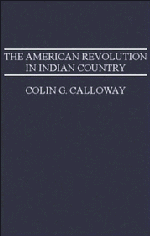Book contents
- Frontmatter
- Dedication
- Contents
- List of figures and maps
- Preface
- Acknowledgments
- Abbreviations
- Prologue New worlds for all: Indian America by 1775
- 1 Corn wars and civil wars: the American Revolution comes to Indian country
- 2 Odanak: Abenaki ambiguity in the North
- 3 Stockbridge: the New England patriots
- 4 Oquaga: dissension and destruction on the Susquehanna
- 5 Fort Niagara: the politics of hunger in a refugee community
- 6 Maquachake: the perils of neutrality in the Ohio country
- 7 Chota: Cherokee beloved town in a world at war
- 8 Tchoukafala: the continuing Chickasaw struggle for independence
- 9 Cuscowilla: Seminole loyalism and Seminole genesis
- 10 The peace that brought no peace
- Epilogue A world without Indians?
- Index
Prologue - New worlds for all: Indian America by 1775
Published online by Cambridge University Press: 18 December 2014
- Frontmatter
- Dedication
- Contents
- List of figures and maps
- Preface
- Acknowledgments
- Abbreviations
- Prologue New worlds for all: Indian America by 1775
- 1 Corn wars and civil wars: the American Revolution comes to Indian country
- 2 Odanak: Abenaki ambiguity in the North
- 3 Stockbridge: the New England patriots
- 4 Oquaga: dissension and destruction on the Susquehanna
- 5 Fort Niagara: the politics of hunger in a refugee community
- 6 Maquachake: the perils of neutrality in the Ohio country
- 7 Chota: Cherokee beloved town in a world at war
- 8 Tchoukafala: the continuing Chickasaw struggle for independence
- 9 Cuscowilla: Seminole loyalism and Seminole genesis
- 10 The peace that brought no peace
- Epilogue A world without Indians?
- Index
Summary
In the summer of 1775, as news of the opening conflicts in the American Revolution spread west, a young Englishman recently arrived from Derbyshire in search of good land traveled to the “Indian country” of the Ohio Valley. Nicholas Cresswell went with a party that consisted of two Englishmen, two Irishmen, a Welshman, two Dutchmen, two Virginians, two Mary landers, a Swede, an African, and a mulatto. On August 27, Cresswell visited a mission town of Moravian Delawares at Wal-hack-tap-poke or Schönbrunn, a settlement of sixty log houses covered with clapboards, arranged along neatly laidout streets, and a meeting house with a bell and glass windows. The parson preached through an interpreter, the Indian congregation sang hymns in Delaware, and the service was conducted with “the greatest regularity, order, and decorum, I ever saw in any place of Worship in my life.” Four days later, Cresswell was at the Delaware town of Coshocton, where he participated in an Indian dance. The beating of drums, the gourd rattles, the rattling of deer hooves on the knees and ankles of the male dancers, and the jingling of the women's bells struck Cresswell's ears as “the most unharmonious concert that human idea can possibly conceive,” and the sight of an “Indian Conjuror” in a mask and bear skin was “frightful enough to scare the Devil.”
Indian America by 1775 was a landscape of cultural polyphony, or more accurately perhaps, cultural cacophony, a country of mixed and mixing peoples. Cresswell's brief sojourn among the Delawares exposed him to some of Indian country's diversity and to its mixture of change and continuity. He saw Indians who wore European clothes but retained traditional loincloths and nose rings. He noted that they had learned to curse from Europeans, observed that white traders cheated them blind whenever they could, lamented the destructive effects of alcohol, and learned that smallpox had “made terrible havoc.”
- Type
- Chapter
- Information
- The American Revolution in Indian CountryCrisis and Diversity in Native American Communities, pp. 1 - 25Publisher: Cambridge University PressPrint publication year: 1995



